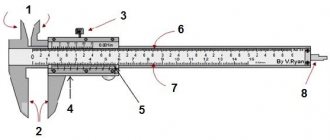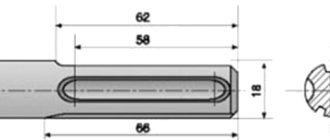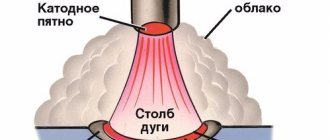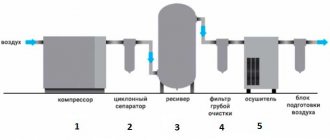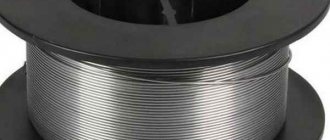MIG-MAG welding was invented in the 50s of the XX century, and its main principles are successfully used today. Usually, if we talk about welding in a semi-automatic mode, then it almost always means MIG and MAG methods. This welding is universal, it is easy to use and guarantees a high-quality result. The full and correct name of this type of welding is the abbreviation GMAW - Gas metal arc welding, which translates as electric arc welding of metal in a shielding gas environment. Among professionals, amateurs and equipment manufacturers, such welding is most often referred to as:
- MIG (Metal Inert Gas) – here the insulating medium is an inert gas: argon or helium.
- MAG (Metal Activ Gas) - the process occurs using an active gas: carbon dioxide or nitrogen, etc.
In our article we will consider issues related to semi-automatic welding using various methods:
- MIG welding
- MAG welding
- MAG welding mode in carbon dioxide environment
- Semiautomatic machines for MIG-MAG welding
- Advantages of semi-automatic equipment for MIG-MAG welding
- The relationship between current and wire diameter when welding various metals
- Automatic wire feeder in MIG/MAG machines
- Operating modes of semi-automatic MIG-MAG
- Wire for semi-automatic MIG/MAG machines
MIG/MAG welding technology
MIG/MAG welding is carried out in semi-automatic mode. The automatic welding machine operates in an atmosphere of inert or active gaseous substances. During welding, an arc lights up between the workpiece and the welding wire (electrode). Under the influence of the heat of the arc, the material being welded is completely melted. As a result of this process, a weld pool is formed. It is protected from oxygen by a gaseous substance supplied by the burner nozzle. Over time, the elements in the weld pool begin to crystallize, forming a weld.
It is necessary to select a shielding gas in accordance with the material of the part being welded and its thickness. When welding non-ferrous metals in a semi-automatic mode, mixtures of argon or helium are used. When welding cobalt or copper materials, nitrogen is used. When welding steels, carbon oxides are used. To improve the strength of the ignited arc and accelerate the formation of the weld, mixtures of MIG and MAG gases are often used.
The following types of MIG/MAG welding are distinguished:
- Large droplet: carried out without short circuits.
- Fine: During welding, small particles of metal are separated from the metal. This type of welding is carried out without short circuits.
- Without short circuits: produced during welding of materials at low voltage welding current.
In semi-automatic drop transfer welding, the welding current density increases, which leads to an increase in arc voltage. As a result, the character of the electrode changes. Large particles are separated from the welded product. The disadvantage of this type of welding is high spatter rates. For this reason, the quality of welding of parts in the ceiling position decreases.
Welding with small droplet transfer is carried out at high voltages and high density welding current. With it, the welded material in a molten state flows into the weld pool. Therefore, this welding method is also called jet welding. When welding products with small droplet transfer, the intensity of heat transfer increases, which leads to a change in the shape of the weld. The main difference between this method of semi-automatic welding is the stability of the burning arc. This means that the welding current voltage does not change.
When welding parts without causing short circuits, the metal in the molten state is transformed into a drop, which leads to an increase in the voltage and length of the burning arc to maximum values. The intensity of the current supply remains unchanged, so the material in the molten state moves into the weld pool until a short circuit occurs.
In addition to semi-automatic MIG/MAG welding, there are 2 other types of welding: MMA and TIG. The decoding of these abbreviations means “manualmetalarc” and “TungstenInertGas”. The main difference between MIG/MAG welding and MMA and TIG welding is the high potential when supplying electrodes and gaseous substances. This increases the welder's work efficiency. Unlike MIG/MAG technology, TIG or MMA welding does not require a large number of machines and tools, because the welding process is different in manual mode.
Unlike other metal welding technologies, MIG/MAG welding has the following features:
- Small time costs for changing welding wires.
- The welding process is fully automated.
- Metals can be welded in any spatial position.
The main disadvantage of this technology is the large losses due to the spattering of molten material, which is associated with the powerful radiation of the burning arc and restrictions on the supply of welding current. When MIG/MAG welding of products, it is also necessary to purchase special welding machines (semi-automatic) that act as a source of electricity and a gas distribution mechanism.
Seam formation
In MIG/MAG welding, a weld is formed by melting the electrode wire. As a result of this process, the basic welding materials crystallize. The resulting seam is reliably protected from exposure to atmospheric air by a gas film. Its size and shape depend on the characteristics of the transfer of material into the weld pool. As heat transfer increases, a small depression is formed in the weld pool, which affects the weld formation procedure.
MMA
mma technology diagram
In our country, the definition of manual arc welding (and the abbreviation RDS) is common. It is cheaper and easier to organize production and less demanding on equipment.
The connection of two elements in MMA occurs using an electrode - a metal rod coated with a coating containing substances that help maintain the arc, protect the welding zone, and form a seam with the desired properties. When voltage is applied, a stable short circuit is formed between the rod and the workpiece, leading to their mutual melting.
The difficulty may come from requiring welder qualifications. To obtain a neat and reliable joint, skill and long experience are required.
In MMA, special attention is paid to the condition of the electrodes, which should not be wet or crumbling. Do not neglect pre-drying and checking.
Advantages and disadvantages
The following advantages of welding in semi-automatic mode are highlighted:
- Allows the use of high voltage welding current.
- High quality welds.
- Allows you to weld products with a wide range of thicknesses.
- Allows the process of seam formation.
- Does not require the use of slag or flux.
- Allows you to create tight connections of galvanized products without damaging the coating of the parts being welded.
- Provides the ability to weld thin steel or aluminum sheets up to 0.5 mm thick.
- Base materials are not exposed to dirt or corrosion during welding.
The main disadvantages of MIG/MAG technology are:
- Requires the purchase of expensive semi-automatic devices.
- High complexity of technology.
- It is impossible to weld parts in hard-to-reach places, which is due to the large difference in the sizes of the torch and electric holder.
- Mandatory preparation and cleaning of the edges of the parts to be welded.
- The ignited arc emits a large amount of light energy, which leads to an increase in radiation. For this reason, the welder is required to use protective face masks while working.
- Strong splashing of metal in a molten state.
Compared to TIG technology, MIG/MAG welding is used in industrial sectors. This is due to the complete mechanization of the welding process, which reduces production costs in the long term.
What else to pay attention to
Among the additional points, we recommend paying attention to the following features of semi-automatic welding machines:
- Number of rollers.
There are 2 or 4. The upper rollers press the wire (driven), and the lower rollers support and push (driving). A mechanism with 4 rollers delivers the additive more evenly, without slipping or jerking. For particularly critical seams, choose this option. For a summer house or non-critical structures, a device with 2 rollers is sufficient. - Wire feed adjustment method.
It can be stepped or smooth. The stepped one sets the wire to run at preset speeds of the electric motor. Smooth allows you to more accurately regulate the feed so that the wire does not burn in the air and does not “make holes” in the weld pool.
- Pulse function.
Provides welding on a base current with periodic pulses of increased strength. Base and pulse current amps and pulse frequency are separately adjustable. The function is useful when semi-automatically welding aluminum. Thanks to the base current, heat input is reduced and workpiece deformation is reduced. With the help of a pulsed current, the oxide film is well penetrated.
- Other welding modes.
If you periodically need to cut metal or burn a hole in a plane, a semi-automatic machine with the ability to switch to MMA welding will be useful. A holder is installed in it and the gas supply is turned off. For accurate welding of thin stainless steel and narrow seams on other metals, it is practical to buy a MIG machine with the ability to switch to TIG welding. There are “3 in 1” models that combine all methods.
Of course, buyers pay attention to the price of the product, but the manufacturer is also important. For example, the service life of semi-automatic devices BARSVELD, ESAB, Lincoln Electric, Fronius is much longer than that of cheap MIG inverters. With the same declared characteristics of branded models, actual indicators rarely deviate from the passport ones.
Application area
MIG/MAG technology is used for:
- Welding plates with a thickness of no more than 0.5 mm. When working with these materials, it is necessary to increase the heat supply intensity. This will avoid plate deformation and increase productivity.
- Welding low-alloy materials with low carbon content.
- Welding products made of iron or aluminum alloys in all spatial positions
- Welding plates made of non-ferrous metals of medium size (up to 0.2 cm).
Due to the fact that the MIG/MAG method allows welding dissimilar metals of all classes, it is actively used in many industries. This technology has found application in the production of automobiles, marine vessels and offshore structures. The use of semi-automatic welding in production requires a lot of professional skills and abilities from the welder. The worker must be able to operate welding machines consisting of a large number of substructures. When organizing industrial production using MIG/MAG welding, you need to carefully prepare the work shops: set up ventilation and purchase stationary welding devices. Otherwise, the gas system will operate unstably due to exposure to drafts.
Types of equipment for MIG/MAG welding
To weld parts using MIG/MAG technology, power sources are required. Their role is played by rectifiers and inverters. They allow you to increase the amplitude of high-frequency voltage. There are 3 categories of inverters for welding:
- Household: most often used by novice welders for one-time projects. They can weld small parts. The welding current of household rectifiers is no more than 200 A.
- Professional: Used by welders working in small commercial settings. They can weld large parts without losing quality. The welding current of professional inverters is 300 A.
- Industrial: used in large industrial organizations. They are capable of continuously welding large structures while maintaining basic weld size and shape requirements. The welding current of industrial rectifiers is no more than 500 A.
Inverters ensure stability of the welding current and reduce the range of spatter of the molten electrode. The versatility of this device allows it to work with stainless steel and aluminum. Rectifiers consume a small amount of electricity. They are small in size, which improves comfort during welding work.
In domestic conditions, an inverter semiautomatic device with a Euro connector is most often used, allowing you to quickly connect the burner. Rectifiers allow welding in 2 modes, both in an inert gas atmosphere and using fleece. For frequent use, it is recommended to buy universal welding machines that can work using different welding technologies. Their main disadvantage is their high cost.
Selecting a device
When purchasing a welding machine, you must consider the following indicators:
- Power type: It is recommended to purchase devices that operate on direct current. When activated in reverse polarity, these devices provide better performance. Devices operating with alternating current and straight polarity are not able to maintain a stable voltage on the arc, which leads to increased metal spattering and a change in the shape of the weld.
- Mains voltage: single-phase or three-phase. Universal welding machines operate at a voltage of 220 V. It is important that the devices are protected from power surges. Otherwise, they will not be able to work in networks with different power supplies.
- Temperature limits: Most welding machines operate at temperatures between -40°C and +40°C. At higher values of this indicator, devices are automatically turned off.
- Availability of additional options: modern machines are capable of performing MMA and TIG welding. By combining many functions, they can be used to solve a large number of problems. Also, modern models have support for HotStart, AntiStick and ArcForce options.
The main technical characteristics of the welding machine are indicated in the device passport. It is important that the device is made of durable materials and has a long warranty period.
Selecting consumables
The main consumable material required for welding is welding wire. Its diameter must correspond to the thickness of the material being welded. Also, the part and the wire must be made of identical materials.
When welding, it is necessary to select the correct shielding gas. When processing parts made of non-ferrous metals, it is better to use inert gaseous substances (helium, argon and their mixtures). When working with iron alloys, it is recommended to use carbon monoxide. It is important that in this case the welding wire contains an increased amount of silicon and manganese. Experienced specialists recommend using mixtures of active and inert gases that reduce the range of metal splashing.
Selecting a semi-automatic machine by characteristics
MIG/MAG devices have key characteristics that are worth considering when choosing
Current strength HideRead more
This means the maximum value. It can be from 160 to 500 A. It affects the maximum melted thickness of the metal. A table of the relationship between the number of amps and the cross-section of the workpiece will help you see the current ranges for welding tasks.
| Current strength, A | Metal thickness, mm |
| 70-80 | 1.5 |
| 90-110 | 2 |
| 120-140 | 3 |
| 140-160 | 4 |
| 160-200 | 5 |
| 220-300 | 6-10 |
| 330-500 | 12-20 |
If you need to weld only profile pipes and sheet iron up to 2-3 mm, a semi-automatic machine with 160 A is enough. To have a small supply, it is better to buy a MIG inverter with 200 A. Welding corners and strips of metal with a cross-section of 6 mm will require a semi-automatic machine with 250 A. For production it is better buy a 300 A or 350 A model.
By connection current HideMore
There are MIG inverters for connection to a 220 V network. They can be used from a regular outlet in a garage or in the courtyard of a private house, if the power of the equipment matches the characteristics of the wiring. Semi-automatic machines at 380 V have increased power and are suitable for production or a large workshop, but they will require three-phase power. There are universal models that connect to both 220 and 380 V. They are optimal for stationary and field work.
Open circuit voltage HideRead more
The characteristic affects the ease of igniting the arc. When you press the torch button, a primary voltage appears at the terminals, exciting an electric arc. The higher it is, the better. For home welding work, 30-40 V is sufficient. For a car repair shop, buy a semi-automatic machine with an open circuit voltage of 70 V. In production, welding equipment with a characteristic of 80-90 V is used.
Useful inclusion (PV) HideRead more
The switching duration is set at an ambient temperature of +40 degrees. For 10 minutes, it is measured how long the semi-automatic machine can cook continuously until the overheating protection is triggered. Based on the results, the equipment is assigned a characteristic, which can be PV 30, 40, 60, 80 or 100%, i.e. it can cook for 3, 4, 6, 8 or 10 minutes out of 10.
If you have to do combined work of welding, cleaning, grinding, cutting workpieces, then a semi-automatic machine with a duty cycle of 40% is sufficient. While preparatory actions are underway, it will have time to cool down. When the welder primarily welds and is only occasionally busy with other processes, MIG machines with a duty cycle of 80-100% are chosen. For a home workshop, buy a model with 60% duty cycle.
